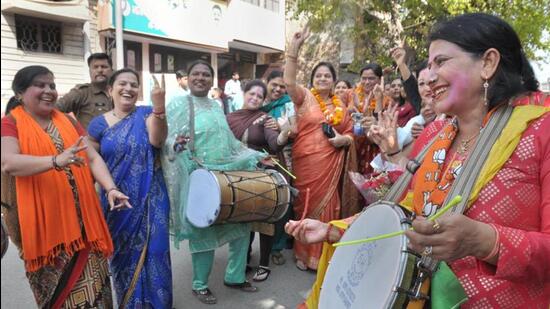Assembly polls: How backroom planning helped BJP script victory in Uttar Pradesh
Allies were a key part of the BJP’s plan to win the UP polls. Tickets were distributed to the pre-poll allies after detailed discussions
The Bharatiya Janata Party (BJP) spectacularly winning a second consecutive term in Uttar Pradesh was scripted as much through big ticket rallies, roadshows and outreach campaigns as through careful backroom planning.

So detailed was the backroom planning that even in Lakhimpur Kheri, the BJP won all the eight seats though the district had become a big hub of opposition protest after the October 3 incident in which farmers were run over by a vehicle.
Political experts said that despite the opposition attempts to focus on Lakhimpur Kheri and Hathras incidents and weave a narrative against the BJP, the public backed the new “M-Y” factor in UP politics. The “M-Y” factor now means not “Muslim-Yadav” combination of the Samajwadi Party but the “Modi-Yogi” combine. There were losses too — 10 of Yogi Adityanath government’s ministers lost. Despite setbacks, the BJP managed to ensure that anti-incumbency didn’t affect it much.
Both Prime Minister Narendra Modi and chief minister Yogi Adityanath had acknowledged the role of “naari shakti (women voters)” in these elections and 29 of the 48 women contestants who won on the BJP ticket are proof, party leaders agreed.
This is BJP’s biggest ever tally of women MLAs. Women contestants as well as women voters played a key part in shaping the BJP narrative that was focused on “suraksha (security)”.
“Much thought went into candidate selection. You would recall that while our top leaders were discussing candidates in Delhi, there was a conspiracy by our political opponents to change the narrative. But, the kind of planning and detailing that has become the hallmark of the BJP since 2014 ensured that we triumphed,” said UP BJP vice president Vijay Bahadur Pathak, the in-charge of the party’s women’s wing in the state.
Allies were a key part of the BJP’s plan. Tickets were distributed to the pre-poll allies after detailed discussions. After several rounds of talks with top leadership, the party finalised ticket distribution and seat-share. Fifteen Nishad party candidates contested the polls, five of them on the BJP symbol. Six Nishad party candidates won on their own symbols in alliance with the BJP. All the five others who contested on the BJP symbol also won.
Such was the seat distribution plan that BJP ally Apna Dal (Sonelal) won 12 of the 17 assembly seats it contested in Uttar Pradesh to emerge as the third largest party in the state after the BJP and the Samajwadi Party. In 2017, the Apna Dal (Sonelal) had won nine seats in alliance with the BJP.
“We have been growing each time,” said Union minister of state and Apna Dal (Sonelal) leader Anupriya Patel who met chief minister Yogi Adityanath in Lucknow on Friday.
The allies played a key role in shaping the BJP win, especially in east UP by bagging 23 of the 32 seats BJP left for them. When it came to selecting its own candidates, the BJP relied on surveys and ground-level cadre feedback to field 214 sitting lawmakers and 170 of them won. It dropped 104 sitting lawmakers where it fielded newer candidates, 80 of whom won. In 85 assembly seats that the BJP had failed to win even in the Modi wave of 2017, the party put in place a mixed strategy. For 16 seats, it again fielded the same candidates who had lost in 2017. Of these, four won. On 69 other seats, where it replaced candidates, 19 won.
The BJP relied on new faces for 170 seats– all after detailed planning.
“Opponents kept focusing on caste, while our ‘labarthi (beneficiary)’ initiatives broke through caste and community barriers. You would have seen that the PM, during his victory speech in Delhi, mentioned that he intends to reach each and every poor. With such visionary and thoughtful leadership, under Yogi ji’s stewardship in UP, we connected with beneficiaries in a big way and they backed us,” said Pathak.
The BJP won all the nine assembly seats in Gorakhpur. Chief minister Yogi Adityanath, contesting his first assembly election, won the Gorakhpur Urban seat by over one lakh votes. The party won all the 19 assembly seats in Bundelkhand region and all the eight assembly seats in Hardoi district too. In Hardoi, the BJP had won over influential Samajwadi Party leader Naresh Agarwal and his son Nitin, a minister in the Samajwadi Party government, too, had sided with the BJP. In Sonbhadra, too, the party won all four seats. It bagged eight of the nine assembly seats in Sitapur.
In Lucknow, the Lok Sabha constituency of defence minister Rajnath Singh, the BJP won seven of the nine assembly seats. In Varanasi, the Lok Sabha constituency of Prime Minister Narendra Modi, the BJP won seven seats and its ally Apna Dal (Sonelal) bagged one. The BJP won eight of the nine assembly seats in Bareilly and seven seats each in Deoria, Shahjahanpur and Gonda.
UP BJP chief Swatantra Dev said, “People have reposed faith in the visionary leadership of Prime Minister Narendra Modi and UP chief minister Yogi Adityanath. It’s a mandate against caste and dynastic politics. It’s a mandate for continuance of the good governance and pro-poor focus that UP witnessed for five years.”





